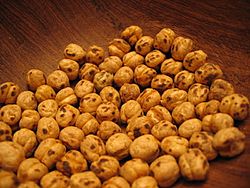Leblebi facts for kids

Leblebi, dehulled
|
|
| Type | Snack |
|---|---|
| Place of origin | Turkey and Middle East |
| Main ingredients | Chickpeas |
| Nutritional value per 100 g (3.5 oz) | |
|---|---|
| Energy | 1,493 kJ (357 kcal) |
|
58.06 g
|
|
| Dietary fiber | 7.74 g |
|
5.04 g
|
|
| Saturated | 0.74 g |
|
Protein
|
19.94 g
|
| †Percentages estimated using US recommendations for adults. | |
Leblebi (Turkish: leblebi; Mesopotamian Arabic: لبلبي, romanized: leblebi; Arabic: قضامة, romanized: Qdameh, Qudamah; Persian: نخودچی, romanized: Nokhodchi; Sicilian: Càlia) is a tasty snack made from roasted chickpeas. It's very popular in countries like Turkey, Iran, and many places in the Middle East and Greece. People often enjoy leblebi plain, or they might add salt, spicy flavors, or even a sweet candy coating! In Tunisia, "leblebi" means something different: it's a warm, hearty breakfast soup made with chickpeas, eggs, and bread.
Contents
What are Leblebi Chickpeas?
To make leblebi, special chickpeas are chosen. Farmers look for chickpeas that are large, light-colored, round, and smooth. These are often called Kabuli chickpeas. It's also important that the outer skin (hull) of the chickpea is easy to remove. The time when the chickpeas are harvested also affects the quality of the leblebi. After harvesting, chickpeas are cleaned and sorted by size. Any chickpeas that are not fully grown, damaged, or broken are removed.
Types of Leblebi Snacks
There are two main kinds of leblebi:
- Dehulled leblebi: This means the outer skin has been removed. Examples include Sarı Leblebi (Yellow Leblebi) and Girit Leblebi.
- Nondehulled leblebi: This type still has its skin on. Examples are Beyaz Leblebi (White Leblebi) and Sakız Leblebi.
These different types of leblebi first came from Anatolia (which is part of modern-day Turkey). From there, they spread to North Africa, the Middle East, Europe, and parts of Asia. Today, Turkey is a major producer of leblebi, especially the city of Çorum. You can also find special local kinds like Ağın Leblebi and Mardin Leblebi.
History of Leblebi
We don't know exactly when leblebi was first made. However, people believe this roasted chickpea snack started in Iran between the years 1000 and 1500 CE.
How Leblebi is Made
Making leblebi is an old tradition, and the steps can vary a bit. The tools used usually help with cleaning, sorting, and heating the chickpeas. Here are the general steps:
- Cleaning and grading: First, the chickpeas are cleaned and sorted by size and quality.
- Soaking: Next, they are soaked in water.
- Tempering: This involves preheating the chickpeas and then letting them rest.
- Boiling: The chickpeas are then boiled.
- Resting: After boiling, they rest again.
- Roasting: This is the most important step, where the chickpeas are roasted until they are crispy.
- Dehulling: Finally, for some types of leblebi, the outer skin is removed.
Where Does the Name "Leblebi" Come From?
The word "leblebi" probably comes from the Arabic word leblab (لبلاب). This word refers to a type of plant called Lablab, which has edible beans. So, "leblebi" likely means "made from leblab."
Leblebi Around the World
Roasted chickpeas are a popular snack not just in Turkey, but also in many other places. You can find them enjoyed in Iran, across the Middle East, in Central Asia, Greece (where they are called stragalia), and even in Sicily, Italy.
Fun Fact
An Ottoman-Armenian composer named Tigran Chukhajian (who lived from 1837 to 1898) wrote an operetta (a short, light opera) in 1875. It was called Leblebidji Hor-Hor Agha, which means "The Chickpea Vendor."

